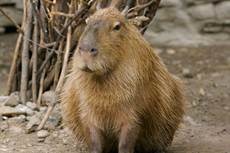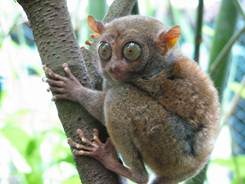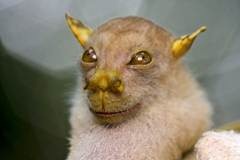13 Weird and Wonderful Jungle Creatures
Sunday, August 27th, 2017

The world’s jungles are some of the richest habitats on earth, home to hundreds of species from the weird to the wonderful to the mysterious. Here are just a few of the majestic beasts who call the jungle their home.
1. Okapi
Okapi are brown with light tan or grey cheeks, throat and chest. Their upper forelegs are stripy, their lower legs have brown lined white socks to the knees and a brown band circles each leg.
It looks like a cross between a zebra and a deer. SOURCE
- Only discovered in 1901
- Elusive, not much is known about them
- Okapi mothers use infrasonic communication with their calves, which is below the range of human hearing.
- Females are slightly taller than males
- Prefer altitudes between 500 and 100 metres
[Source]
2. Proboscis Monkey
Distinguished by their prominent nose these monkeys are a brownish-yellow, with hints of grey and black.
‘Proboscis’ is a nice way of saying ‘big nose’. SOURCE
- Grow up 70cm
- Males can weigh up to 50lbs
- Only eat unripe fruit
- Males use their fleshy, pendulous noses to attract a mate
- The nose amplifies their call, impressing females and intimidating rivals
- They are prolific swimmers
[Source]
3. Green Basilisk Lizard
Bright green in colour with a black striped, whip-like tail. Males have high crests on their back and head.
This Lizard is so cool it can literally walk on water. SOURCE
- Sometimes called the Jesus Lizard because it can run on water
- Can sprint, upright, for around 15 feet at 5 feet per second across the surface
- Grow to about 2 feet (61 cm)
- Lays up to 20 eggs
- Hatchlings are born with the ability to run on land and water, climb and swim
[Source]
4. Capybara
These reddish-brown, pig -like rodents from South America have small ears, short legs and two long front teeth.
This rodent is roughly 4 times the size of an average rat. SOURCE
- Largest rodents in the world
- 3-4 feet long
- Eat their own dung
- Weighs 100-150 pounds
- Highly adapted to an aquatic lifestyle
- Can purr and bark
[Source]
5. Aye-aye
This odd looking primate has bat-like ears, rat-like teeth, one long bony finger and huge eyes.
Rabbits aren’t the only creatures that get “caught in the headlights”. SOURCE
- Feeds on insects and larvae
- Finds food by tapping on tree bark
- Taps up to 8 times a second
- Primarily nocturnal
- Sleep exclusively in the highest canopies (700m elevation)
[Source]
6. Glass Frog
Tiny and green with translucent skin on the underside, and sometimes on the top.
These tiny amphibians are as fragile as their name suggests. SOURCE
- Grows to between 1.4cm and 3cm
- Most live in the canopy of the rainforest, only coming low down to breed
- Unlike other frogs their eyes face forwards
- Their bones are visible through their skin and are green, rather than white
- There are 134 species of glass frog
[Source]
7. Sun bear
Small with short black/dark brown fur and a yellowish crest on their chest, the sun bear is a striking creature.
A bear in serious need of a manicure. SOURCE
- Grows up to 120-150cm in length
- Males weigh up to 65kg, females up to 50kg
- Smallest species of bear
- Sickle-shaped claws and long tongues are adapted to foraging termites
- Mainly feed on fruits, berries, insects
- Does not hibernate due to year round abundance of food
8. Tapir
Tapirs vaguely resemble pigs but with a short, prehensile trunk, which is actually an extended upper lip.
This Tapir is disguised as a Panda. SOURCE
- Feeds each morning and evening on aquatic plants
- Follows tunnel like paths created by many tapir to reach water holes and feeding grounds
- Spreads seeds from their food when defecating, promoting plant growth
- Excellent swimmers
- The biggest Tapir weighs 800 pounds
[Source]
9. Poison Dart Frog
Beautifully coloured frogs, depending on habitat they can be yellow, gold, copper, red, green, blue or black.
Small but deadly. SOURCE
- Tiny, around 1-2 inches in size
- Live for 3-15 years
- A group is called an ‘army’
- Only natural predator is a snake called Leimadophis epinephelus
- A 2inch long golden poison dart frog has enough venom to kill 10 grown men
[Source]
10. Tarsier
Small with huge eyes, thin tails, long fingers and extended hind limbs.
Tarsier’s always win staring matches. SOURCE
- Each eye is the same size and weight as their brain
- Longest hind limbs relative to body length of any mammal
- 18 species and subspecies
- Born with fur and eyes open, can climb within an hour of birth
- Eats mainly insects, occasionally snakes, lizards and birds
11. Mandrill
Males have orangey-yellow beards and a bright red and blue snout and rump, females and juveniles have dull blue snouts and little beards.
The most fashionable monkey around. SOURCE
- Most colourful mammals in the world
- When excited their skin colours brighten
- Live for over 46 years
- Grow up to 81cm in length with a 7cm tail
- Weigh up to 27kg
- Some groups have up 200 members
[Source]
12. Harpy Eagle
Adults have a black upper body, white and black banded undersides and a grey neck with divided crest.
This is the real גBig Bird’. SOURCE
- One of the world’s largest raptors
- Plucks monkeys and sloth out of the trees with its huge feet and talons
- Grows up to 35-40 inches in length
- Weighs up to 15.5lbs
- Hind talons can equal the size of grizzly bear claws
- Generally live below 900m but can be found up to 2000m (above sea level)
[Source]
13. Tube-nosed “Yoda” bat
They have large, rounded heads with large eyes and long, tubular nostrils extending sideways. Long grey-brown fur covers their back, their undersides are yellowish and have been likened to Yoda from Star Wars.
- Discovered in 2009
- Grow up to 80cm in length
- Weigh up to 45g
- Feed on rainforest fruits and blossoms
- Their nostrils may assist them in directional location of fruit
BONUS CREATURE “Olinguito”
With rich, red-coloured fur this member of the raccoon family has taken over a decade to identify. It’s habitat stretches from Peru to Venezuela where it can be found in ‘cloud forests’.
Don’t let its cuddly face deceive you this is a vicious carnivore. SOURCE
- Discovered in 2013
- First new carnivore to be discovered in 35 years
- 70 cm in length from nose to tail
- 35cm body and 35cm tail
- Weighs up to 900g
As the Olinguito shows there are many more weird and wonderful undiscovered creatures across the world. New and exotic species are waiting to be found in the mysterious depths of the jungle, we just need to keep searching.
Sources:
*Tube-Nose Bat photo courtesy of Piotr Naskrecki, Conservation International
Aye-aye – www.environmentalgraffiti.com
Glass Frog – www.environmentalgraffiti.com
Sun bear – www.bbc.co.uk/nature
Tapir – www.nationalgeographic.co.uk
Poison Dart frog – www.nationalgeographic.co.uk
Tarsier – www.bbc.co.uk/nature & http://www.endangeredspeciesinternational.org/tarsiersection.html
Mandrill – www.bbc.co.uk/nature
Harpy Eagle – www.worldlandtrust.org
Tube-nosed “Yoda” bat – www.nationalgeographic.co.uk & www.bbc.co.uk/nature
Proboscis monkey – www.nationalgeographic.co.uk
Green Basilisk Lizard – www.nationalgeographic.co.uk














